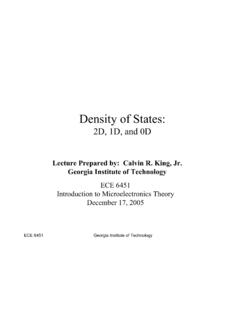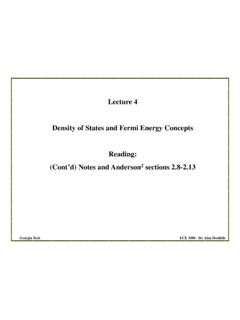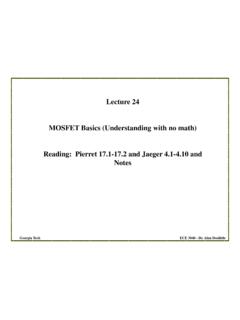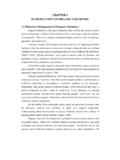Transcription of Angular Momentum and Central Forces - Georgia Institute …
1 Angular Momentum and Central Forces Lecture prepared by : Shivaly Reddy ECE 6451 - Introduction to the theory of Microelectronics Fall 2005. Introduction to Angular Momentum and Central Forces What is a Central force ? A particle that moves under the influence of a force towards a fixed origin (also called Central field) has conserved physical observables such as energy, Angular Momentum , etc. In a Central force problem there is no external torque acting on the system The law of conservation of Angular Momentum is a statement about the rotational symmetry of a system (Kevin. F Brennan, ). dL d dr dp = (r p) = p + r = 0. dt dt dt dt In a given system if Angular Momentum is conserved then it is rotationally symmetric.
2 , the particle's wave function periodically ends in itself (can see in later slides). However, when an external field is applied to the system, the Angular Momentum is no longer symmetric. The applied force influences the particle to move in certain direction breaking the rotational symmetry. Example of rotational symmetry For example, lets consider the electron and proton in a hydrogen atom. The Central field would be the force they exert on each other pulling towards the centre of Mass G. The Angular Momentum of the particle is a constant of motion (proved later on in the slides) the eigen states of the energy operator would be the same as the eigen states for the Angular Momentum . In this example, if there were interference from another particle (external field), the direction of movement of the particle is altered thus breaking the symmetry of space What would you see in this lecture Angular Momentum operator L commutes with the total energy Hamiltonian operator (H).
3 Commutation relationship between different Momentum operators Commutation of L with H. Commutation of L2 with H. Calculating eigen values for L2 with same eigen states as for H. Calculating eigen values for Ф with L2 operator Calculating eigen values for with L2 operator Spherical Harmonics to calculated eigen values for L and L2 using m and l values Lowering and raising Momentum operators changes the z-component by one quantum number Angular Momentum A particle at position r1 with linear Momentum p has Angular Momentum ,, r r r L=r p Where r = r(x,y,z) and Momentum vector is given by, r h d d d . p= , , . i dx dy dz . Therefore Angular Momentum can be written as, r r hv L=r . i Writing L in the matrix form and evaluating it gives the Lx, Ly and Lz components.
4 I j . k . r h . L= x y z . i d d d .. dx dy dz . r h d d d d d d . L = y z i + z x j + x y k . i dz dy dx dz dy dx . Cont Therefore, r h d d d . L = ( yp zp )i + zp x j + x y k . i dz dy dx . z y x r L = L i + L j + L k . x y z In order to simplify the equation further we must consider the commutation of below, [L , y ] = [( yp x z zp ), y ] = z[ p , y ] = + z (hi ) = ihz y y [( yp z zp ), y ] = ( yp zp )* y y * ( yp zp y z y z y ). h = y p z zyp y p + yzp = izh 2 2. i z y z y [L , y ] = izh x Commutation Properties Similarly we can show, [L , p ] = ihp x y z [L , x] = 0. x [L , p ] = 0. x x If two operators do not commute, then from definition they cannot be found simultaneously, it can be shown that Lx and Ly do not commute therefore different components of Angular Momentum cannot be simultaneously determined.
5 The commutation of Lx and Ly is given by, Similarly the commutation of other components is, [L , L ] = ihL. x y z As it can be seen, the individual components of L ( Angular Momentum ). operator do not commute with each other therefore they cannot be simultaneously found [L , L ] = ihL. y z x [L , L ] = ihL. z x y [L , L] = 0. 2. L2 operator A new operator L2 is introduced because, this operator commutes with each individual components of L, however the components of L does not commute with each other. L2 is given by, 2. L =L +L +L. 2. x 2. y 2. z When a measurement is made, we can find the total Angular Momentum and only one other component at a time. For example, if a wave function is an eigenfunction of Lz then it is not an eigenfunction of Lx and Ly Taking measurement of Angular Momentum along Lz (applying an external field), shows the total Angular Momentum direction in figure below.
6 When a particle is under the influence of a Central (symmetrical) potential, then L commutes with potential energy V(r). If L commutes with kinetic energy, then L is a constant of motion. If L commutes with Hamiltonian operator (kinetic energy plus potential energy) then the Angular Momentum and energy can be known simultaneously. Lz r L. Angular Momentum Constant of Motion Proof: To show if L commutes with H, then L is a constant of motion. General Case: Let A is a time-independent operator, then d d d d * d . ih [ (t ) A (t )] = ih (t ) A (t ) + ih (t ) A (t ) ih . = H * ih = H . dt dt dt dt dt d d *. ih A. *. + ih A = * AH H * A = * [ A, H ] . dt dt Integrating above equation through all space we get, d ( A )d r = ( AH HA) d r * 3 * 3.
7 Ih dt But expectation value of A, ( A )d r = A. * 3. Therefore, ih d ( A) = ( AH HA). dt Since A is time independent, is zero. Therefore when a time independent operator commutes with H, it's a constant of motion L2 commutation with H. Similarly since L is time independent, it can be said that if L commutes with H, then the time rate of change of L is zero and it is constant of motion. Since L2 is of high interest, it must be shown that L2 commutes with H. It is easier to prove the above in spherical coordinates, but first writing Angular Momentum in spherical coordinates we get, graphical representation of spherical coordinates h h 1 1 . p = = r + + . i i r r sin r .. Where r, , are written as, r = sin cos i + sin sin j + cos k = sin i + cos j r r r = cos cos i + cos sin j sin k But L = r p h h 1.
8 Writing L in terms of radial coordinates we get, L = r p = r r = . i i sin . The i,j and k components of L are given as, h . L = sin cot cos i + (cos cot sin ) j + k . i . Spherical Coordinates Vs Plane Coordinates In spherical Coordinate System a point P is represented by three componets 0 r radius 0 180 o Theta 0 180 o Phi Where r is the radius, the distance between origin and point P. Theta is the angle between the line joining point P to the . origin and z-axis Phi is the angle between is the angle between the x-axis and . the line projection on the XY plane. Click to get back to the slides.. Spherical Coordinate System Note: The used in the slides is represented by in the picture and like versa.
9 Calculating components of L2. Given individual components of L given we can calculate L2 components : . L = sin + cot cos * sin + cot cos . 2.. x .. = sin sin + sin cot cos + cot cos sin .. + cot cos cot cos .. Ly = cos cot sin * cos cot sin . 2.. = cos cos + cos cot sin + cot sin cos .. + cot sin cot sin .. 2 2. Lz = 2.. Calculating components for L2 Cont'. Adding the squares of Lx,Ly and Lz components we get, 1 2 2. 2. L = + cot +. sin 2 2 2 . cot =cos /sin taking 1/sin out of the last two terms we get 1 2 1 . 2. L = + cos + sin . sin 2 2 sin . d/dt(sin )=cos replacing it in the above equation 1 2 1 . 2. L = + ( sin ) + sin . sin 2 2 sin . d d d The last two terms of in the form ( x) y + x( ) y = ( xy ) , by simplifying it we get dx dx dx 1 2 1.
10 L = 2. + (sin ) . sin . 2 2. sin . As it can be seen that L and L2 is independent of r, therefore it commutes with any function of r or its derivative. Potential energy V(r). is a function of r. Therefore V(r) commutes with both L and L2. L2 commutation with the Hamiltonian Operator The L2 operator needs to commute with the kinetic energy operator in order to commute with Hamiltonian operator as Hamiltonian operator is the sum of potential and kinetic energy. The kinetic energy operator in terms of L2 and r is given as, p 2. L h . 2 2. T = = r . 2. 2m 2mr 2mr r r . 2 2. Since potential energy operator is dependent on radial component and kinetic energy is dependent only on L2 operator and radial component, L2 commutes with H operator because an operator can commute with another independent operator or with itself.










![arXiv:1909.00881v2 [hep-th] 8 Sep 2019 dark matter.](/cache/preview/c/b/e/a/b/5/0/d/thumb-cbeab50d7510780c369e8df2989f7d8f.jpg)


